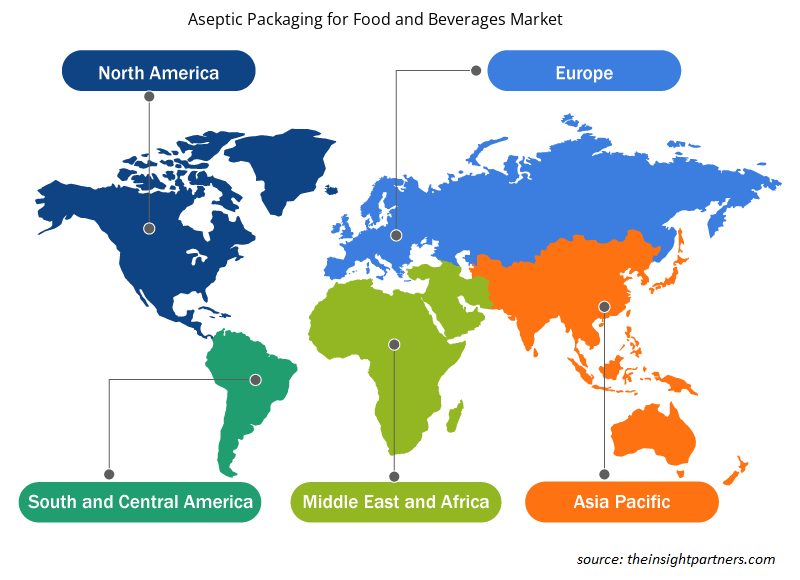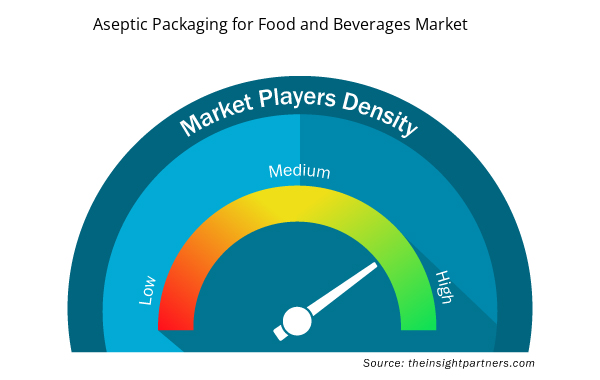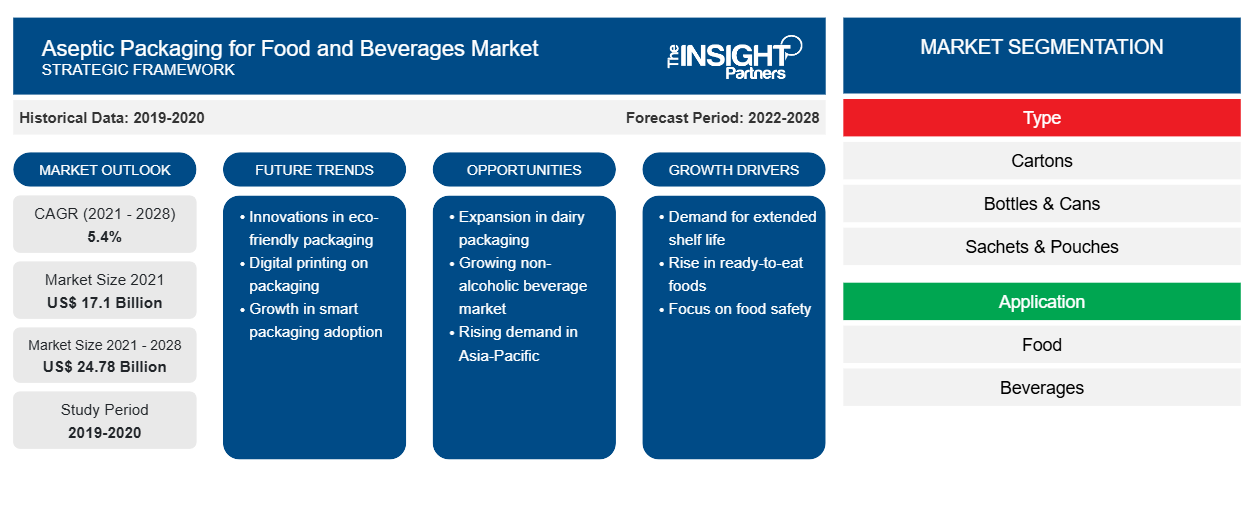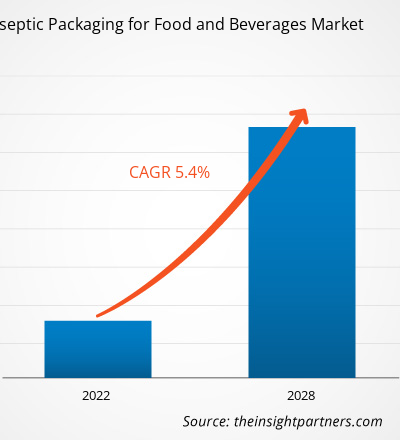Der Markt für aseptische Verpackungen für Lebensmittel und Getränke soll von 17.097,86 Millionen US-Dollar im Jahr 2021 auf 24.782,33 Millionen US-Dollar im Jahr 2028 anwachsen; von 2021 bis 2028 wird mit einer durchschnittlichen jährlichen Wachstumsrate von 5,4 % gerechnet.
Aseptische Verpackung ist ein thermischer Prozess mit hoher Temperatur und kurzer Dauer, der verwendet wird, um ein Produkt kommerziell zu sterilisieren und das gekühlte, sterilisierte Produkt in einer sterilisierten Umgebung in eine vorsterilisierte Verpackung zu füllen. Während des Prozesses ist der aseptische Füller so konzipiert, dass er das Verpackungsmaterial sterilisiert, das sterile Produkt in einer sterilisierten Umgebung in den Behälter füllt und die Verpackung dann hermetisch versiegelt. Aseptische Füller unterscheiden sich von herkömmlichen Lebensmittelverpackungssystemen, da hier das Lebensmittelprodukt und die Verpackung separat sterilisiert werden. Die aseptische Verpackung wird hauptsächlich in der Lebensmittel- und Getränkeindustrie verwendet. Das massive Wachstum der globalen Lebensmittel- und Getränkeindustrie ist auf die steigende Bevölkerung, den verbesserten Lebensstil, das steigende Pro-Kopf-Einkommen und die steigende Nachfrage nach Fertiggerichten und Getränken zurückzuführen, was im Prognosezeitraum voraussichtlich entscheidende Chancen für den Markt für aseptische Verpackungen für Lebensmittel und Getränke eröffnen wird .
Nordamerika hatte im Jahr 2020 den größten Anteil am globalen Markt für aseptische Verpackungen für Lebensmittel und Getränke, während für den asiatisch-pazifischen Raum im Prognosezeitraum ein deutliches Wachstum erwartet wird. Das Konzept „Ready-to-eat“ oder „Ready-to-drink“ liegt in Nordamerika im Trend. In letzter Zeit ist der Markt für trinkfertige Getränke aufgrund der wachsenden Vorliebe für Convenience-Food und -Getränke, die Zeit und Mühe sparen, erheblich gewachsen. Aseptische Verpackungen für Lebensmittel und Getränke sind unerlässlich, um deren Haltbarkeit zu verlängern. Der steigende Trend zum Konsum trinkfertiger Getränke treibt daher das Wachstum des nordamerikanischen Marktes für aseptische Verpackungen für Lebensmittel und Getränke voran. Anbieter bieten spezielle aseptische Verpackungen für trinkfertige Produkte an. Graham Packaging bietet beispielsweise recycelbaren Kunststoff für aseptische Verpackungen an, um die Haltbarkeit von Einzelportionsverpackungen zu verlängern. Daher treiben verschiedene aufstrebende und etablierte Marktteilnehmer in der Region, die innovative aseptische Verpackungslösungen anbieten, das Marktwachstum voran.
Passen Sie diesen Bericht Ihren Anforderungen an
Sie erhalten kostenlose Anpassungen an jedem Bericht, einschließlich Teilen dieses Berichts oder einer Analyse auf Länderebene, eines Excel-Datenpakets sowie tolle Angebote und Rabatte für Start-ups und Universitäten.
- Holen Sie sich die wichtigsten Markttrends aus diesem Bericht.Dieses KOSTENLOSE Beispiel umfasst eine Datenanalyse von Markttrends bis hin zu Schätzungen und Prognosen.
Auswirkungen der COVID-19-Pandemie auf den Markt für aseptische Verpackungen für Lebensmittel und Getränke
Während der COVID-19-Pandemie stand die Chemie- und Materialindustrie vor beispiellosen Herausforderungen aufgrund der Rohstoffknappheit, der Schließung von Fabriken, des Arbeitskräftemangels und anderer betrieblicher Schwierigkeiten im Rahmen der Pandemie-Sicherheitsprotokolle. Die Schließung von Produktionseinheiten, Schwierigkeiten bei der Beschaffung von Rohstoffen und Einschränkungen der Logistik wirkten sich negativ auf den globalen Markt für aseptische Verpackungen für Lebensmittel und Getränke aus. Aufgrund des COVID-19-Ausbruchs nahmen die Hygienebedenken der Verbraucher erheblich zu. Die Verbraucherpräferenzen entwickeln sich rasch in Richtung langer Haltbarkeit und steriler Verpackung, was sich positiv auf die aseptische Verpackung für den Lebensmittel- und Getränkemarkt auswirkte. Laut einer E-Commerce-Studie im Tetra Pak Index 2021 bewerteten Verbraucher aseptische Kartons zunehmend als ideales Verpackungsmaterial für Online-Einkäufe. Die gestiegene Besorgnis über Lebensmittelsicherheit und Hygiene aufgrund des Ausbruchs von COVID-19 treibt also das Wachstum der aseptischen Verpackung für Lebensmittel und Getränke an. Somit hatte die COVID-19-Pandemie gemischte Auswirkungen auf den Markt für aseptische Verpackungen für Lebensmittel und Getränke.
Markteinblicke
Vorteile der aseptischen Verpackung treiben das Marktwachstum voran
Die aseptische Verpackung von Lebensmitteln und Getränken bietet verschiedene Vorteile. Aseptische Verpackungen tragen dazu bei, die Haltbarkeit von Lebensmitteln und Getränken ohne Kühlung um schätzungsweise sechs bis zwölf Monate zu verlängern. Die längere Haltbarkeit des Produkts gibt den Herstellern mehr Zeit, ihre Produkte zu versenden und zu verkaufen, bevor sie ablaufen oder an Geschmack verlieren. Dies reduziert auch die Transport- und Logistikkosten. Aseptische Verpackungen sind im Vergleich zu traditionelleren Verpackungsarten leicht und kompakt, sodass die Hersteller durch Reduzierung des Versandgewichts die Versandkosten senken können. Es besteht eine wachsende Nachfrage nach Fertiggerichten mit langer Haltbarkeit, die entweder frei von bakterieller Kontamination sind oder diese verzögern können. Lebensmittelkonservierungsmittel werden in der Lebensmittelproduktion häufig verwendet, um die Haltbarkeit zu verlängern und die Qualität des Produkts zu erhalten. Verbraucher bevorzugen jedoch natürlichere Produkte, die frei von synthetischen Zusatzstoffen sind. Aseptische Verpackungen ergänzen auch natürliche Zutaten und ermöglichen es einem Hersteller, ein vollständig natürliches Produkt herzustellen und es zunehmend haltbar zu machen. Daher treiben verschiedene Vorteile der aseptischen Verpackung das Wachstum des Marktes für aseptische Verpackungen für Lebensmittel und Getränke voran.
Typ-Einblicke
Der Markt für aseptische Verpackungen für Lebensmittel und Getränke ist nach Typ in Kartons, Flaschen und Dosen, Sachets und Beutel und Sonstige unterteilt. Das Segment Sachets und Beutel wird im Prognosezeitraum voraussichtlich die höchste durchschnittliche jährliche Wachstumsrate auf dem globalen Markt für aseptische Verpackungen für Lebensmittel und Getränke aufweisen. Die aseptische Beutelverpackung umfasst eine innovative Ausgießer- und Verschlusslösung, um eine sichere und praktische Verpackungslösung zu ermöglichen. Dieser Beutel wurde entwickelt, um Verbrauchern Komfort und Benutzerfreundlichkeit zu bieten. Er kann bis zu 12 Monate haltbar sein und bietet gleichzeitig optimale Nährstoff-, Geschmacks- und Texturerhaltung. Sachets sind kleine versiegelte flexible Beutel, die eine drei- oder vierschichtige Verpackung aus Rollen- oder Flachfolie umfassen. Die steigende Nachfrage nach Lebensmitteln und Getränken in kleineren Mengen treibt das Wachstum des Segments aseptischer Sachets und Beutel voran.
Regionale Einblicke in den Markt für aseptische Verpackungen für Lebensmittel und Getränke
Die regionalen Trends und Faktoren, die den Markt für aseptische Verpackungen für Lebensmittel und Getränke während des Prognosezeitraums beeinflussen, wurden von den Analysten von Insight Partners ausführlich erläutert. In diesem Abschnitt werden auch Marktsegmente und Geografien für aseptische Verpackungen für Lebensmittel und Getränke in Nordamerika, Europa, im asiatisch-pazifischen Raum, im Nahen Osten und Afrika sowie in Süd- und Mittelamerika erörtert.

- Erhalten Sie regionale Daten zum Markt für aseptische Verpackungen für Lebensmittel und Getränke
Umfang des Marktberichts „Aseptische Verpackung für Lebensmittel und Getränke“
| Berichtsattribut | Details |
|---|---|
| Marktgröße im Jahr 2021 | 17,1 Milliarden US-Dollar |
| Marktgröße bis 2028 | 24,78 Milliarden US-Dollar |
| Globale CAGR (2021 - 2028) | 5,4 % |
| Historische Daten | 2019-2020 |
| Prognosezeitraum | 2022–2028 |
| Abgedeckte Segmente | Nach Typ
|
| Abgedeckte Regionen und Länder | Nordamerika
|
| Marktführer und wichtige Unternehmensprofile |
|
Marktteilnehmerdichte für aseptische Verpackungen für Lebensmittel und Getränke: Auswirkungen auf die Geschäftsdynamik verstehen
Der Markt für aseptische Verpackungen für Lebensmittel und Getränke wächst rasant. Dies wird durch die steigende Nachfrage der Endverbraucher aufgrund von Faktoren wie sich entwickelnden Verbraucherpräferenzen, technologischen Fortschritten und einem größeren Bewusstsein für die Vorteile des Produkts vorangetrieben. Mit der steigenden Nachfrage erweitern Unternehmen ihr Angebot, entwickeln Innovationen, um die Bedürfnisse der Verbraucher zu erfüllen, und nutzen neue Trends, was das Marktwachstum weiter ankurbelt.
Die Marktteilnehmerdichte bezieht sich auf die Verteilung von Firmen oder Unternehmen, die in einem bestimmten Markt oder einer bestimmten Branche tätig sind. Sie gibt an, wie viele Wettbewerber (Marktteilnehmer) in einem bestimmten Marktraum im Verhältnis zu seiner Größe oder seinem gesamten Marktwert präsent sind.
Die wichtigsten Unternehmen auf dem Markt für aseptische Verpackungen für Lebensmittel und Getränke sind:
- Tetra Pak International SA
- Abgedichtete Luft
- Greatview Aseptische Verpackungsfirma
- SIDEL GROUP
- ECOLEAN AB
Haftungsausschluss : Die oben aufgeführten Unternehmen sind nicht in einer bestimmten Reihenfolge aufgeführt.

- Erhalten Sie einen Überblick über die wichtigsten Akteure auf dem Markt für aseptische Verpackungen für Lebensmittel und Getränke
Anwendungseinblicke
Basierend auf der Anwendung ist der Markt für aseptische Verpackungen für Lebensmittel und Getränke in Lebensmittel und Getränke unterteilt. Das Lebensmittelsegment ist weiter unterteilt in Milchprodukte, Obst und Gemüse, Fleisch, Geflügel und Meeresfrüchte, verarbeitete Lebensmittel und andere. Das Getränkesegment ist weiter unterteilt in Milchgetränke, Säfte, trinkfertige Getränke und andere. Das Getränkesegment hatte im Jahr 2020 einen größeren Anteil am Weltmarkt. Aseptische Verpackungen werden für verschiedene Getränke verwendet, darunter Getränke auf Frucht-, Milch- und Milchbasis, Proteinshakes, trinkfertigen Tee und Eiskaffee, aromatisiertes Wasser und Cocktails. Die wachsende Nachfrage der Verbraucher nach Getränken ohne Chemikalien und Konservierungsstoffe treibt das Wachstum der aseptischen Verpackungen für den Markt für Lebensmittel und Getränke voran.
Zu den wichtigsten Akteuren auf dem Markt für aseptische Verpackungen für Lebensmittel und Getränke zählen Tetra Pak International SA, Sealed Air, Greatview Aseptic Packaging Company, Sidel Group, ECOLEAN AB, Krones AG, Syntegon Technology GmbH (Bosch Packaging Technology), Amcor Group GmbH, IPI Srl und SIG Combibloc Group AG. Diese Akteure entwickeln innovative Produkte, um den neuen Verbrauchertrends gerecht zu werden. Darüber hinaus sind sie an Fusionen und Übernahmen, Geschäftserweiterungen und Partnerschaften beteiligt, um ihren Marktanteil weltweit auszubauen.
Bericht-Spotlights
- Fortschrittliche Branchentrends auf dem Markt für aseptische Verpackungen für Lebensmittel und Getränke helfen den Akteuren bei der Entwicklung wirksamer langfristiger Strategien
- In Industrie- und Entwicklungsländern angewandte Strategien für Unternehmenswachstum
- Quantitative Analyse des Marktes für aseptische Verpackungen für Lebensmittel und Getränke von 2019 bis 2028
- Schätzung der weltweiten Nachfrage nach aseptischen Verpackungen für Lebensmittel und Getränke
- Porters Fünf-Kräfte-Analyse zur Veranschaulichung der Wirksamkeit von Käufern und Lieferanten in der Branche
- Aktuelle Entwicklungen zum Verständnis des wettbewerbsorientierten Marktszenarios
- Markttrends und -aussichten sowie Faktoren, die das Wachstum des Marktes für aseptische Verpackungen für Lebensmittel und Getränke vorantreiben und bremsen
- Unterstützung im Entscheidungsprozess durch Aufzeigen von Marktstrategien, die das kommerzielle Interesse untermauern und zum Marktwachstum führen
- Die Größe des Marktes für aseptische Verpackungen für Lebensmittel und Getränke an verschiedenen Knotenpunkten
- Detaillierte Übersicht und Segmentierung des Marktes sowie der Dynamik der aseptischen Verpackung für Lebensmittel und Getränke
- Größe des Marktes für aseptische Verpackungen für Lebensmittel und Getränke in verschiedenen Regionen mit vielversprechenden Wachstumschancen
- Historische Analyse (2 Jahre), Basisjahr, Prognose (7 Jahre) mit CAGR
- PEST- und SWOT-Analyse
- Marktgröße Wert/Volumen – Global, Regional, Land
- Branche und Wettbewerbsumfeld
- Excel-Datensatz



Report Coverage
Revenue forecast, Company Analysis, Industry landscape, Growth factors, and Trends

Segment Covered
This text is related
to segments covered.

Regional Scope
North America, Europe, Asia Pacific, Middle East & Africa, South & Central America

Country Scope
This text is related
to country scope.
Häufig gestellte Fragen
Adoption of sustainable and environmental-friendly packaging is the key trend for the global aseptic packaging for food and beverage market. The increased use of plastic packaging in the food and beverage industry has harmful impacts on the environment. This has led to an increased focus on developing sustainable and environmental-friendly packaging.
Based on food & beverage, the food segment led the global aseptic packaging for food and beverage market in 2020. In the food segment fruits & vegetable, product is increasing as it is perishable in nature and aseptic packaging helps to increase longer shelf life. Thus this increase demand for aseptic packaging for food and beverage.
Based on the type segment, sachets & pouches was the fastest-growing segment in 2020. The aseptic sachets & pouch packaging is pre-made, sterilized spouted sachets & pouch packaging which is used to preserve the quality of the product. Aseptic sachets & pouch are shelf-stable and require no refrigeration.
In 2020, Asia Pacific accounted for the largest share of the global aseptic packaging for food and beverage market. The aseptic packaging for food and beverage market industry is anticipated to expand faster due to its benefits like longer shelf life of food and beverage.
Surging demand for dairy products and benefits associated with aseptic packaging are the drivers for global aseptic packaging for food and beverage market. The growing demand for dairy products has led to an increased focus on developing safe and hygienic packaging for dairy products. Aseptic packaging is increasingly used as a packaging solution for ultra-high temperature (UHT) milk. Aseptic packaging helps increase the shelf life of the food and beverage products.
The major players operating in the global aseptic packaging for food and beverage market are Tetra Pak International S.A.; Sealed Air Corporation; Greatview Aseptic Packaging Co., Ltd.; Sidel International; Ecolean AB; Krones AG; Syntegon Technology GmbH; IPI S.r.l.; SIG Combibloc Group AG; Amcor plc.
Trends and growth analysis reports related to Chemicals and Materials : READ MORE..
The List of Companies - Aseptic Packaging for Food and Beverage Market
- Tetra Pak International S.A
- Sealed Air
- Greatview Aseptic Packaging Company
- SIDEL GROUP
- ECOLEAN AB
- Krones AG
- Syntegon Technology GmbH (Bosch Packaging Technology)
- SIG Combibloc Group AG
- IPI S.R.L.
- Amcor plc
The Insight Partners performs research in 4 major stages: Data Collection & Secondary Research, Primary Research, Data Analysis and Data Triangulation & Final Review.
- Data Collection and Secondary Research:
As a market research and consulting firm operating from a decade, we have published and advised several client across the globe. First step for any study will start with an assessment of currently available data and insights from existing reports. Further, historical and current market information is collected from Investor Presentations, Annual Reports, SEC Filings, etc., and other information related to company’s performance and market positioning are gathered from Paid Databases (Factiva, Hoovers, and Reuters) and various other publications available in public domain.
Several associations trade associates, technical forums, institutes, societies and organization are accessed to gain technical as well as market related insights through their publications such as research papers, blogs and press releases related to the studies are referred to get cues about the market. Further, white papers, journals, magazines, and other news articles published in last 3 years are scrutinized and analyzed to understand the current market trends.
- Primary Research:
The primarily interview analysis comprise of data obtained from industry participants interview and answers to survey questions gathered by in-house primary team.
For primary research, interviews are conducted with industry experts/CEOs/Marketing Managers/VPs/Subject Matter Experts from both demand and supply side to get a 360-degree view of the market. The primary team conducts several interviews based on the complexity of the markets to understand the various market trends and dynamics which makes research more credible and precise.
A typical research interview fulfils the following functions:
- Provides first-hand information on the market size, market trends, growth trends, competitive landscape, and outlook
- Validates and strengthens in-house secondary research findings
- Develops the analysis team’s expertise and market understanding
Primary research involves email interactions and telephone interviews for each market, category, segment, and sub-segment across geographies. The participants who typically take part in such a process include, but are not limited to:
- Industry participants: VPs, business development managers, market intelligence managers and national sales managers
- Outside experts: Valuation experts, research analysts and key opinion leaders specializing in the electronics and semiconductor industry.
Below is the breakup of our primary respondents by company, designation, and region:

Once we receive the confirmation from primary research sources or primary respondents, we finalize the base year market estimation and forecast the data as per the macroeconomic and microeconomic factors assessed during data collection.
- Data Analysis:
Once data is validated through both secondary as well as primary respondents, we finalize the market estimations by hypothesis formulation and factor analysis at regional and country level.
- Macro-Economic Factor Analysis:
We analyse macroeconomic indicators such the gross domestic product (GDP), increase in the demand for goods and services across industries, technological advancement, regional economic growth, governmental policies, the influence of COVID-19, PEST analysis, and other aspects. This analysis aids in setting benchmarks for various nations/regions and approximating market splits. Additionally, the general trend of the aforementioned components aid in determining the market's development possibilities.
- Country Level Data:
Various factors that are especially aligned to the country are taken into account to determine the market size for a certain area and country, including the presence of vendors, such as headquarters and offices, the country's GDP, demand patterns, and industry growth. To comprehend the market dynamics for the nation, a number of growth variables, inhibitors, application areas, and current market trends are researched. The aforementioned elements aid in determining the country's overall market's growth potential.
- Company Profile:
The “Table of Contents” is formulated by listing and analyzing more than 25 - 30 companies operating in the market ecosystem across geographies. However, we profile only 10 companies as a standard practice in our syndicate reports. These 10 companies comprise leading, emerging, and regional players. Nonetheless, our analysis is not restricted to the 10 listed companies, we also analyze other companies present in the market to develop a holistic view and understand the prevailing trends. The “Company Profiles” section in the report covers key facts, business description, products & services, financial information, SWOT analysis, and key developments. The financial information presented is extracted from the annual reports and official documents of the publicly listed companies. Upon collecting the information for the sections of respective companies, we verify them via various primary sources and then compile the data in respective company profiles. The company level information helps us in deriving the base number as well as in forecasting the market size.
- Developing Base Number:
Aggregation of sales statistics (2020-2022) and macro-economic factor, and other secondary and primary research insights are utilized to arrive at base number and related market shares for 2022. The data gaps are identified in this step and relevant market data is analyzed, collected from paid primary interviews or databases. On finalizing the base year market size, forecasts are developed on the basis of macro-economic, industry and market growth factors and company level analysis.
- Data Triangulation and Final Review:
The market findings and base year market size calculations are validated from supply as well as demand side. Demand side validations are based on macro-economic factor analysis and benchmarks for respective regions and countries. In case of supply side validations, revenues of major companies are estimated (in case not available) based on industry benchmark, approximate number of employees, product portfolio, and primary interviews revenues are gathered. Further revenue from target product/service segment is assessed to avoid overshooting of market statistics. In case of heavy deviations between supply and demand side values, all thes steps are repeated to achieve synchronization.
We follow an iterative model, wherein we share our research findings with Subject Matter Experts (SME’s) and Key Opinion Leaders (KOLs) until consensus view of the market is not formulated – this model negates any drastic deviation in the opinions of experts. Only validated and universally acceptable research findings are quoted in our reports.
We have important check points that we use to validate our research findings – which we call – data triangulation, where we validate the information, we generate from secondary sources with primary interviews and then we re-validate with our internal data bases and Subject matter experts. This comprehensive model enables us to deliver high quality, reliable data in shortest possible time.


 Holen Sie sich ein kostenloses Muster für diesen Bericht
Holen Sie sich ein kostenloses Muster für diesen Bericht